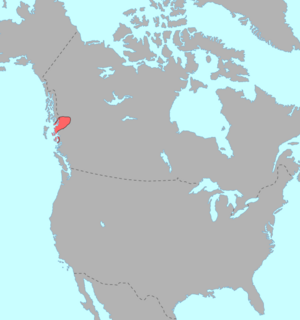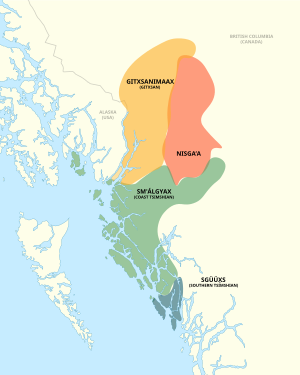Tsimshianic languages facts for kids
Quick facts for kids Tsimshianic |
|
|---|---|
| Tsmksian | |
| Ethnicity: | Tsimshian |
| Geographic distribution: |
British Columbia, Alaska |
| Linguistic classification: | Penutian ?
|
| Subdivisions: |
Maritime Tsimshian
Nass–Gitksan
|
 Pre-contact distribution of Tsimshianic languages
|
|
The Tsimshianic languages are a family of languages spoken in northwestern British Columbia and in Southeast Alaska on Annette Island and Ketchikan. All Tsimshianic languages are endangered, some with only around 400 speakers. Only around 2,170 people of the ethnic Tsimshian /ˈsɪmʃiən/ population in Canada still speak a Tsimshian language; about 50 of the 1,300 Tsimshian people living in Alaska still speak Coast Tsimshian. Tsimshianic languages are considered by most linguists to be an independent language family, with four main languages: Coast Tsimshian, Southern Tsimshian, Nisg̱a’a, and Gitksan.
The Tsimshianic languages were included by Edward Sapir in his Penutian hypothesis, which is currently not widely accepted, at least in its full form. The Penutian connections of Tsimshianic have been reevaluated by Marie-Lucie Tarpent, who finds the idea probable, though others hold that the Tsimshianic family is not closely related to any other North American language.
Family division
Tsimshianic consists of 4 lects:
- Tsimshian (also known as Maritime Tsimshianic, Lower Tsimshian, Northern Tsimshian)
- Coast Tsimshian (also known as Tsimshian proper, Sm’algyax̣, Sm’algax)
- Southern Tsimshian (also known as Sgüüx̣s, Ski:xs, Old Klemtu) †
- Nass–Gitksan (also known as Interior Tsimshianic, Inland Tsimshianic)
Coast Tsimshian is spoken along the lower Skeena River in Northwestern British Columbia, on some neighbouring islands, and to the north at New Metlakatla, Alaska. Southern Tsimshian was spoken on an island quite far south of the Skeena River in the village of Klemtu; however, it became extinct in 2013 with the death of the last speaker. Nisga’a is spoken along the Nass River. Gitksan is spoken along the Upper Skeena River around Hazelton and other areas.
Nisga’a and Gitksan are very closely related and are usually considered dialects of the same language by linguists. However, speakers from both groups consider themselves ethnically separate from each other and from the Tsimshian and thus consider Nisga’a and Gitksan to be separate languages. Coast and Southern Tsimshian are also often regarded as dialects of the same language.
As of 2013, Tsimshian courses are available at the University of Alaska Southeast.
Phonology
Consonantal inventory of Proto-Tsimshian:
| Labial | Dental | Palatal | Velar | Labio- velar |
Uvular | Labio- uvular |
Glottal | |||
|---|---|---|---|---|---|---|---|---|---|---|
| Non-continuous obstruent |
simple | *p | *t | *ts | *k | *kʷ | *q | *qʷ | *ʔ, *ʔʷ | |
| glottalized | *pʼ | *tʼ | *tsʼ | *kʼ | *kʷʼ | *qʼ | *qʷʼ | |||
| Fricative | *s, *ɬ | *x | *χ | *χʷ | *h, *hʷ | |||||
| Approximant | simple | *l | *j | *w | ||||||
| glottalized | *lˀ | *jˀ | *wˀ | |||||||
| Nasal | simple | *m | *n | |||||||
| glottalized | *mˀ | *nˀ | ||||||||
See also
 In Spanish: Lenguas tsimshiánicas para niños
In Spanish: Lenguas tsimshiánicas para niños


